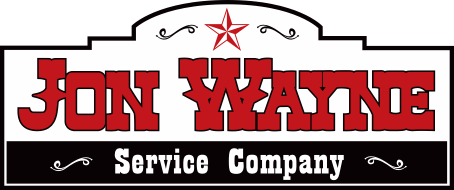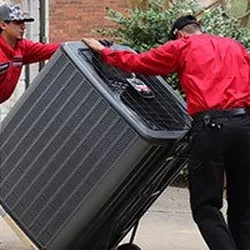How Much Does it Cost to Install a Furnace in the San Antonio Area?
In San Antonio, the cost to install a furnace can vary anywhere from $3,000 to $6,500+.
Of course, the price you end up paying for your furnace replacement may cost more or less than your neighbor. That’s because every furnace installation project is different.
To give you a better idea of what you might pay, we’ll explain the biggest price factors that will impact your cost.
The 6 main factors that affect the cost of a furnace installation include:
- The furnace efficiency
- Upgrades and accessories
- The scope of work involved
- Any necessary ductwork modifications
- The type of warranty you get
- The company you hire
Below, we'll explain each of these cost factors in more detail so that you can better understand what goes into your furnace replacement cost.
Need a down-to-the-penny estimate for your furnace replacement cost? Trust Jon Wayne. We’ve helped thousands of San Antonio homeowners with their furnace replacement needs. We start every project with a thorough in-home inspection and upfront pricing (in writing) for various replacement options—so at the end of the day, you choose what you pay.
Cost factor #1: The furnace itself
Not all furnaces are made equal and therefore different furnace systems come with different pricing. Typically, furnaces with higher efficiency levels and more advanced features will cost more.
When choosing your replacement furnace, you’ll need to consider:
- The efficiency level. A furnace’s efficiency level is indicated by its AFUE rating. The higher the AFUE rating, the more efficient the system and the greater the upfront investment. However, higher AFUE ratings also reduce monthly utility bills.
- System features and enhancements. Furnace’s come with varying comfort features. For example, you’ll need to choose whether you want a single-stage furnace (less expensive) vs a two-stage furnace (more expensive) vs a variable-speed furnace (most expensive). The more expensive features provide more precise, even temperatures throughout the house. They also offer higher efficiency levels, quieter systems and better comfort control.
- The size of the furnace. While the size of the furnace (measured in BTU output) doesn’t impact the price too much, it’s an important factor to consider. That’s because a furnace that is too big or too small will skyrocket your utility bills, need frequent repairs and run a higher risk of premature failure. An HVAC tech should take great care to accurately size your furnace.
- The brand. Much like the furnace size, the brand of a furnace doesn’t actually impact price as much as homeowners might think. In fact, there’s only a few hundred dollars’ difference between brands. The biggest factor to consider is the efficiency level you want and the company you choose to install the system.
Cost factor #2: Upgrades and accessories
The more upgrades and accessories you choose, the higher your overall furnace installation cost.
Some common “upgrades” include:
- Fuel delivery system
- Return chamber modifications
- Combustion removal system (proper venting)
- Media filters
- UV lights
- Air Purifiers
- Smart thermostats
- Zoning systems
- Surge protection
- Safety disconnect switches
- Drain overflow switches
A licensed HVAC technician can help you better understand what upgrade options you have and how they might benefit you.
Cost factor #3: The scope of work
Simply put, the more labor a furnace installation requires, the more you’ll pay overall.
Two of the biggest factors that affect how much labor is required for a furnace installation includes:
- Whether you’re replacing the entire HVAC system or just the indoor furnace. Some homeowners may opt to replace just the indoor furnace (and not replace the AC along with the furnace). However, most of the time, when a furnace is replaced, the AC should also be replaced to maximize efficiency, ratings, and warranties.
- Installation code requirements and system modifications. If certain components of your home’s HVAC system are not up to code, a professional will need to fix these issues during the installation. The more code requirements are needed, the more labor the job will require. Some common modifications include improperly-sized return air chambers and improperly-sized refrigerant lines. Code requirements that may be needed include rebuilding closets to accommodate larger systems, removing door trims and/or removing attic ladders.
Cost factor #4: Any ductwork modifications needed
If ductwork modifications are needed, this will add to your overall furnace installation cost.
Beware that many companies simply swap out HVAC equipment and pay little to no attention to the ductwork. These types of companies are known by industry experts as “box changers” and are not considered quality technicians. That’s because ductwork should be evaluated as a critical part of the overall furnace system.
If the ductwork is in need of replacing, modifying or cleaning and sealing, the homeowner will not get the comfort or efficiency from their furnace that they are paying for. Unfortunately, this scenario is an epidemic in the HVAC industry and is the reason most people never see any real energy savings, even when they purchase a high-efficiency furnace system.
Cost factor #5: The type of warranty you get
An extended warranty will usually increase your installation costs but will save you money on future repairs.
That said, there are two warranty types:
- Manufacturer’s warranty: This warranty is provided by the furnace manufacturer (i.e. Amana or Goodman) and covers the cost of any needed replacement parts due to manufacturer defects. Normal manufacturer’s warranties usually last 1-10 years while the extended warranties last 10 years.
- Service Agreement: This coverage is typically offered by the company you hired for your furnace installation and covers the cost of labor for any repair work needed due to mechanical failure or an installation mistake. If you purchase the service agreement warranty, it will usually last 5 - 10 years after the installation.
To get the most peace of mind and long term savings, we recommend that you purchase extended warranties only if you’re going to live in your current home for 5+ years.
Cost factor #6: The company you hire
Higher-quality service companies with more experience will typically charge more for their work.
However, don’t skimp on this factor. In fact, we suggest you pay a little more upfront for a more reputable company.
Here’s why:
- A more reputable company will provide reliable and honest service before, during and after the installation.
- An experienced, certified and licensed service company will provide high-quality, up-to-code installation work that will result in a longer-lasting and more efficient system
- A more reputable company will often provide longer and more reliable warranties that will give you peace of mind throughout the lifespan of your new furnace
- A higher-quality company will also provide some form of a 100% satisfaction guarantee so that you can be sure they will fix whatever issues pop up during and after the installation
Need a furnace installation in the San Antonio area? Trust Jon Wayne
At Jon Wayne, we’ve served homeowners throughout the San Antonio area for more than 20 years. Throughout that time, we’ve helped thousands of customers upgrade to new, high-efficiency furnaces.
When you choose us for your furnace installation, we promise free estimates, upfront pricing and multiple furnace installation options. Plus, we back every installation with a 5-10-year parts warranty and our 100% satisfaction guarantee.


